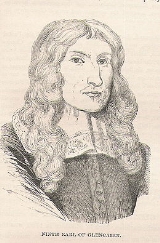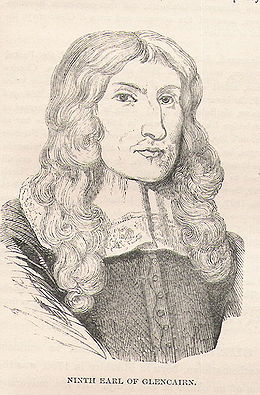
William Cunningham, 8th Earl of Glencairn
Encyclopedia
William Cunningham, 9th Earl of Glencairn (1610–1664), was a Scottish nobleman, Lord Chancellor of Scotland
, and a cavalier
. He was also the chief of Clan Cunningham
.
 The eldest son of William Cunningham, 8th Earl of Glencairn
The eldest son of William Cunningham, 8th Earl of Glencairn
, on 21 July 1637 this William obtained a ratification from King Charles 1st
, under the Royal Sign Manual, of the original Glencairn Letters Patent
of 1488.
He was sworn a member of the Privy Council of Scotland
and in 1641 was appointed a Commissioner of the Treasury
.
and the Earls of Lanark and Roxburgh, in opposing the sending of a Scottish army into England to assist the English Parliamentary Army. For this loyalty he received a (now published) personal letter from the King.
He was appointed Lord Justice General by parliament in 1646. He knew of and is said to have "entered heartily into" the attempted rescue of Charles I
in 1648, and was subsequently deprived by parliament of this post on 15 February 1649, under the Act of Classes
. The parliament, now being dominant, at the instance of the Public Prosecutor, then passed a Decreet, on 2 March 1650, annulling the original Glencairn Letters Patent
of 1488. (This was rescinded at the Restoration}.
Glencairn then led an insurrection in the Highlands
in 1653 (See: Royalist rising of 1651 to 1654) in favour of King Charles II
, when General Monk had possession of Scotland. In January 1654 he was
commissioned by Charles II
to command the Royal forces in all of Scotland, numbering some 3,500 men, but he later handed his command to General Middleton.
About this time Glencairn and Lieutenant-General Sir George Munro, 1st of Newmore
engaged in a duel with both pistols & swords two miles to the south of Dornoch
. Munro had poured scorn on the quality of their forces and Glencairn had defended them, challenging Munro, who lost but was only wounded. Middleton initially placed the Earl under arrest, but the Earl left the army a fortnight later.
He was then arrested by Monck
in 1655, who later permitted him to return home. Glencairn was excepted from Cromwell's Act of Grace and Pardon.
Upon the Restoration
Glencairn waited upon King Charles II at London, when he was again sworn a Privy Councillor and appointed Sheriff Principal
of Ayrshire
. On 19 January 1661, he was constituted Lord Chancellor of Scotland for life, upon the resignation of the Earl of Loudon.
Glencairn was Chancellor of the University of Glasgow
from 1660, and was one of the principal advisors of the re-establishment of Episcopacy
in Scotland. He was not, however, opposed to Presbyterianism, and the subsequent bitter disputes between the two religious factions greatly distressed him and affected his health.
The Earl died at Belton, East Lothian, on 30 May 1663, aged 54 years. He was buried, with great pomp, in the south-east aisle of St. Giles Cathedral in Edinburgh, on the 28th July following.
Lord Chancellor of Scotland
The Lord Chancellor of Scotland was a Great Officer of State in pre-Union Scotland.Holders of the office are known from 1123 onwards, but its duties were occasionally performed by an official of lower status with the title of Keeper of the Great Seal...
, and a cavalier
Cavalier
Cavalier was the name used by Parliamentarians for a Royalist supporter of King Charles I and son Charles II during the English Civil War, the Interregnum, and the Restoration...
. He was also the chief of Clan Cunningham
Clan Cunningham
Clan Cunningham is a Scottish clan. The clan does not currently have a chief, therefore it is considered an Armigerous clan by the Standing Council of Scottish Chiefs, though recently two contenders for the chiefship have emerged...
.

William Cunningham, 8th Earl of Glencairn
William Cunningham, 9th Earl of Glencairn , was a Scottish nobleman, Lord Chancellor of Scotland, and a cavalier. He was also the chief of Clan Cunningham....
, on 21 July 1637 this William obtained a ratification from King Charles 1st
Charles I of England
Charles I was King of England, King of Scotland, and King of Ireland from 27 March 1625 until his execution in 1649. Charles engaged in a struggle for power with the Parliament of England, attempting to obtain royal revenue whilst Parliament sought to curb his Royal prerogative which Charles...
, under the Royal Sign Manual, of the original Glencairn Letters Patent
Letters patent
Letters patent are a type of legal instrument in the form of a published written order issued by a monarch or president, generally granting an office, right, monopoly, title, or status to a person or corporation...
of 1488.
He was sworn a member of the Privy Council of Scotland
Privy Council of Scotland
The Privy Council of Scotland was a body that advised the King.In the range of its functions the council was often more important than the Estates in the running the country. Its registers include a wide range of material on the political, administrative, economic and social affairs of Scotland...
and in 1641 was appointed a Commissioner of the Treasury
Treasurer of Scotland
The Treasurer was a senior post in the pre-Union government of Scotland, the Privy Council of Scotland.The full title of the post was Lord High Treasurer, Comptroller, Collector-General and Treasurer of the New Augmentation, formed as it was from the amalgamation of four earlier offices...
.
Royalist
The Earl supported the Royalist cause of his King, and in 1643 joined with the Duke of HamiltonDuke of Hamilton
Duke of Hamilton is a title in the Peerage of Scotland, created in 1643. It is the senior dukedom in that Peerage , and as such its holder is the Premier Peer of Scotland, as well as being head of both the House of Hamilton and the House of Douglas...
and the Earls of Lanark and Roxburgh, in opposing the sending of a Scottish army into England to assist the English Parliamentary Army. For this loyalty he received a (now published) personal letter from the King.
He was appointed Lord Justice General by parliament in 1646. He knew of and is said to have "entered heartily into" the attempted rescue of Charles I
Charles I of England
Charles I was King of England, King of Scotland, and King of Ireland from 27 March 1625 until his execution in 1649. Charles engaged in a struggle for power with the Parliament of England, attempting to obtain royal revenue whilst Parliament sought to curb his Royal prerogative which Charles...
in 1648, and was subsequently deprived by parliament of this post on 15 February 1649, under the Act of Classes
Act of Classes
The Act of Classes was passed the Scottish Parliament in 23 January 1649. It was probably drafted by Lord Warriston a leading member of the Kirk Party, who along with the Marquess of Argyll were leading proponents of its clauses....
. The parliament, now being dominant, at the instance of the Public Prosecutor, then passed a Decreet, on 2 March 1650, annulling the original Glencairn Letters Patent
Letters patent
Letters patent are a type of legal instrument in the form of a published written order issued by a monarch or president, generally granting an office, right, monopoly, title, or status to a person or corporation...
of 1488. (This was rescinded at the Restoration}.
Glencairn then led an insurrection in the Highlands
Scottish Highlands
The Highlands is an historic region of Scotland. The area is sometimes referred to as the "Scottish Highlands". It was culturally distinguishable from the Lowlands from the later Middle Ages into the modern period, when Lowland Scots replaced Scottish Gaelic throughout most of the Lowlands...
in 1653 (See: Royalist rising of 1651 to 1654) in favour of King Charles II
Charles II of England
Charles II was monarch of the three kingdoms of England, Scotland, and Ireland.Charles II's father, King Charles I, was executed at Whitehall on 30 January 1649, at the climax of the English Civil War...
, when General Monk had possession of Scotland. In January 1654 he was
commissioned by Charles II
Charles II of England
Charles II was monarch of the three kingdoms of England, Scotland, and Ireland.Charles II's father, King Charles I, was executed at Whitehall on 30 January 1649, at the climax of the English Civil War...
to command the Royal forces in all of Scotland, numbering some 3,500 men, but he later handed his command to General Middleton.
About this time Glencairn and Lieutenant-General Sir George Munro, 1st of Newmore
George Munro, 1st of Newmore
Sir George Munro, 1st of Newmore was a 17th century Scottish soldier and member of parliament from the Clan Munro, Ross-shire, Scotland. He was seated at Newmore Castle.-Lineage:...
engaged in a duel with both pistols & swords two miles to the south of Dornoch
Dornoch
Dornoch is a town and seaside resort, and former Royal burgh in the Highlands of Scotland. It lies on the north shore of the Dornoch Firth, near to where it opens into the Moray Firth to the east...
. Munro had poured scorn on the quality of their forces and Glencairn had defended them, challenging Munro, who lost but was only wounded. Middleton initially placed the Earl under arrest, but the Earl left the army a fortnight later.
He was then arrested by Monck
George Monck, 1st Duke of Albemarle
George Monck, 1st Duke of Albemarle, KG was an English soldier and politician and a key figure in the restoration of Charles II.-Early life and career:...
in 1655, who later permitted him to return home. Glencairn was excepted from Cromwell's Act of Grace and Pardon.
Restoration
He was one of the peers whom Monk called to the Convention he summoned when he was about to march into England in 1659. It was at this Convention that Glencairn called for Monk to declare for a free parliament.Upon the Restoration
Restoration (Scotland)
The Restoration of the monarchy began in 1660 when the English, Scottish and Irish monarchies were all restored under Charles II after the government of occupation that followed the Wars of the Three Kingdoms...
Glencairn waited upon King Charles II at London, when he was again sworn a Privy Councillor and appointed Sheriff Principal
Sheriff Principal
The office of sheriff principal is unique within the judicial structure of Scotland, and it cannot therefore readily be compared with any other judicial office. It is one of great antiquity, having existed continuously since around the 11th century...
of Ayrshire
Ayrshire
Ayrshire is a registration county, and former administrative county in south-west Scotland, United Kingdom, located on the shores of the Firth of Clyde. Its principal towns include Ayr, Kilmarnock and Irvine. The town of Troon on the coast has hosted the British Open Golf Championship twice in the...
. On 19 January 1661, he was constituted Lord Chancellor of Scotland for life, upon the resignation of the Earl of Loudon.
Glencairn was Chancellor of the University of Glasgow
University of Glasgow
The University of Glasgow is the fourth-oldest university in the English-speaking world and one of Scotland's four ancient universities. Located in Glasgow, the university was founded in 1451 and is presently one of seventeen British higher education institutions ranked amongst the top 100 of the...
from 1660, and was one of the principal advisors of the re-establishment of Episcopacy
Scottish Episcopal Church
The Scottish Episcopal Church is a Christian church in Scotland, consisting of seven dioceses. Since the 17th century, it has had an identity distinct from the presbyterian Church of Scotland....
in Scotland. He was not, however, opposed to Presbyterianism, and the subsequent bitter disputes between the two religious factions greatly distressed him and affected his health.
The Earl died at Belton, East Lothian, on 30 May 1663, aged 54 years. He was buried, with great pomp, in the south-east aisle of St. Giles Cathedral in Edinburgh, on the 28th July following.

